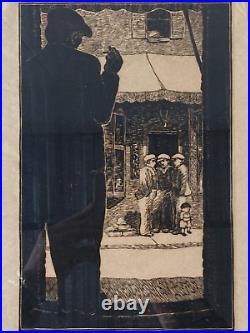

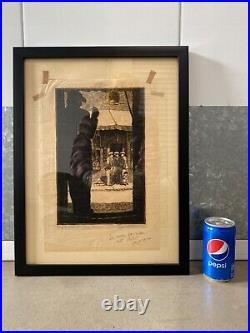
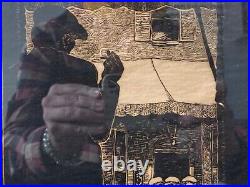
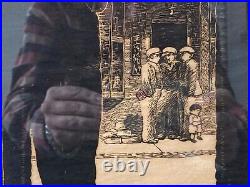
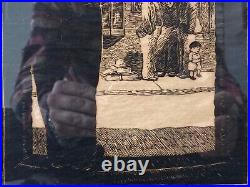
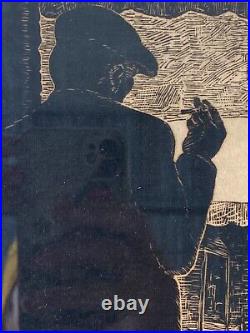


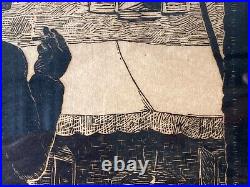
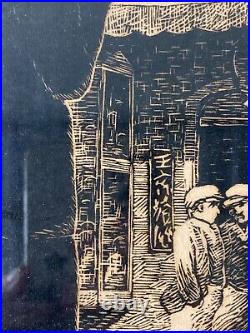
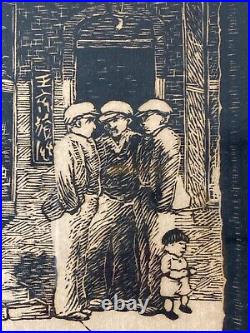
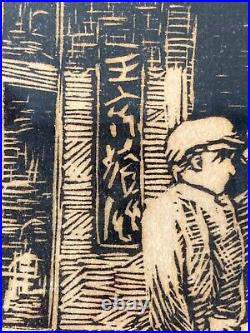
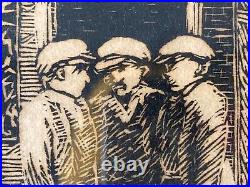
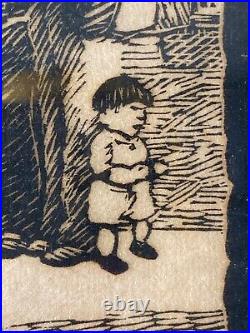
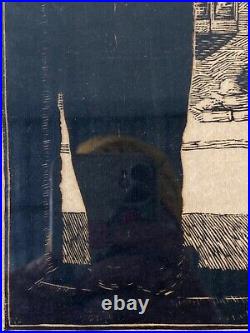
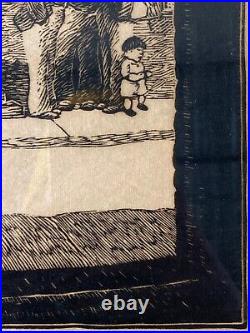
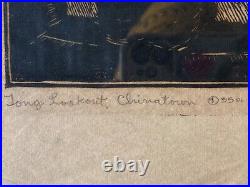
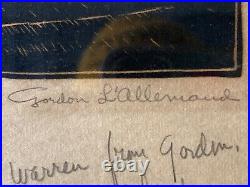
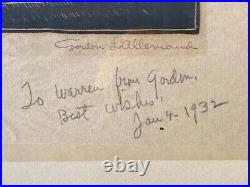
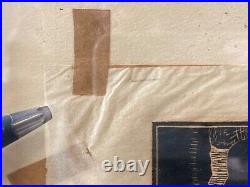
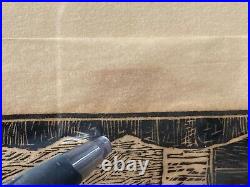



This is a historically significant and Very RARE Antique American WPA Social Realism Woodcut Print on Rice Paper, by early Los Angeles, California journalist, photographer, writer, illustrator, and artist, Gordon Lynn L’Allemand “Allemand” 1903 – 1974. There are limited sources of information on this artist, but perhaps you know more about him or his work? This piece depicts the shadowy silhouette of a Chinese man with a flatcap, smoking a cigarette in an open doorway. Across the alley, several shady characters, and a small child stand in the entryway of a Los Angeles Chinatown Tong clubhouse. In American Chinatowns, Tongs were essentially secret societies or brotherhoods created by Chinese immigrants, which promoted and maintained order and settled community disputes among the minority Chinese population. During the 1930’s, they were often associated with crime, such as prostitution, bootlegging, and operating opium dens. This piece is titled in graphite: “Tong Lookout Chinatown, ” at the lower left edge, and signed: “Gordon L’Allemand” in graphite at the lower right edge. Additionally, there is an annotation in graphite underneath the signature which reads: To Warren from Gordon, Best Wishes. Approximately 13 x 17 inches including frame. Actual artwork is approximately 9 1/2 x 12 5/8 inches. Very good condition for nearly a century of age, and the fragile nature of the rice paper, with expected age-related toning, mild creasing at the edges, and some light discoloration please see photos carefully. Acquired from an old collection in Los Angeles, California. This is the first original artwork by L’Allemand to ever be offered for sale since the invention of the Internet. This early artistic representation of the Los Angeles historic Chinatown is Priced to Sell. If you like what you see, I encourage you to make an Offer. Please check out my other listings for more wonderful and unique artworks! Gordon Lynn L’Allemand. 1903 – Bowling Green, Kentucky. 1974 – San Luis Obispo, California. Born in Bowling Green, KY on April 2, 1903. By the 1920s L’Allemand had settled in Los Angeles and was a pupil of J. He wrote articles for the Times and was the author-illustrator of several books including You Can Grow Dwarf Trees and Pageantry On The Mesa. His subjects include still lifes, figure studies, scenes of Los Angeles, and portraits. He died in San Luis Obispo, CA on Oct. Exh: Laguna Beach AA, 1930; LACMA, 1930 (solo), 1931 (prize); Calif. Art Club, 1930-31; Painters & Sculptors of LA, 1931-37; Bullocks (LA), 1932; Calif. State Fair, 1937; All Calif. Source: Nancy Dustin Moure, Publications in California Art No. Like other major Chinatowns across the country, Old Chinatown had long been represented as a world of underground passages and secret rooms. A 1930 Los Angeles Times article described the community in this way, Tong wars, murders, dope raids, hop-house scandals, white and yellow slavery, underground tunnels, secret trap doors; all have been here. Outside in the streets old men bask lazily in the sunshine and life is peaceful to the eye, but behind barred doors one feels that mystery is eternally seething. 71 In popular articles like these, Old Chinatown was depicted as being not just unseen but unseeable to the eyes of the city’s white population. The stories of underground tunnels reflected broader fears that many whites held of Chinatown and Chinese people somehow being invisible to police and government power. In this way, Old Chinatown was represented as existing outside the legal and juridical boundaries that defined so much of the rest of the city. Indeed one might argue that the idea of being seen or seeable to the broader white population correlated directly with popular perceptions of the perceived governability of the residents of the community. The notion that Chinatown was ridden with tunnels and secret passages reflected dominant fears that the neighborhood’s residents not only could not be seen by the state, the police, or by the white power structure but also that they could not be governed in the same way. Gordon L’Allemand, ” Old Chinatown, ” Los Angeles Times, October 5, 1930, K8.

